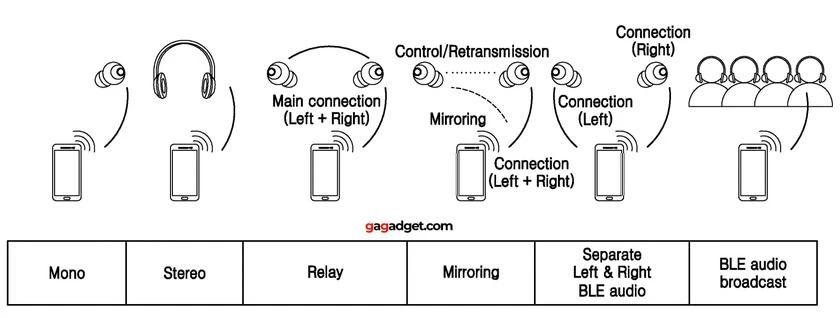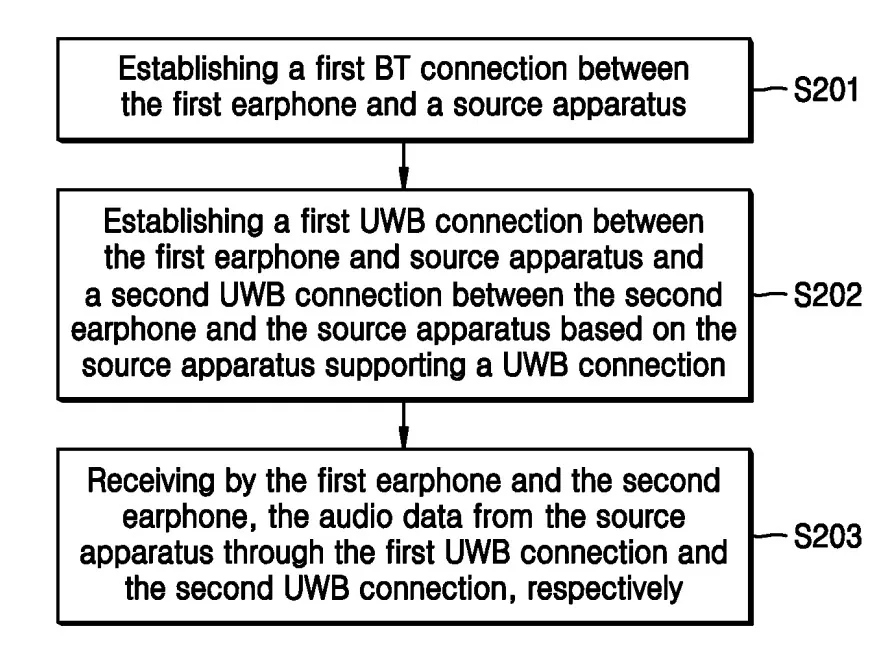The latest news shows that Samsung is considering adding UWB (ultra-wideband) connection technology to future Galaxy Buds wireless headphones. Evidence of this plan comes from a patent application submitted in November 2023 and published this week. The patent application describes a method of connecting wireless headphones to playback devices (such as smartphones) via Bluetooth and UWB. Both the playback device and the headphones must support this connection standard.

Using Ultra-Wideband (UWB) to Stream Audio
According to patent documents filed with the U.S. Patent and Trade Office, Samsung is considering using Ultra-Wideband (UWB) to stream audio in its future wireless earbuds instead of Bluetooth. While the earbuds still require Bluetooth to connect to the source device, after the first earbud switches to UWB, the second earbud will also switch to UWB.
Once these connections are in place, the phone sends data and control information to the primary earbud via UWB, which then forwards the information to the other earbud. After the data transfer is complete, the Bluetooth connection is terminated. Essentially, Bluetooth is responsible for setup and control, while UWB is responsible for data transmission. The idea is to take advantage of both connectivity standards and give them their best features.

Compared with Bluetooth, transmitting audio via UWB has obvious advantages. Samsung claims in the patent that the Galaxy Buds headphones using UWB technology can achieve a transmission rate of up to 20 Mbps, which is much faster than existing Bluetooth technology and performs better in terms of power consumption, interference and delay. This also means that users do not have to worry about the signal instability and delay problems caused by traditional Bluetooth headphones when enjoying a high-quality audio experience.
In addition, high-speed data transmission will also open the door to lossless audio transmission. Lossless audio files retain all the original audio information in the recording in a smaller volume, but the bandwidth of Bluetooth is not enough to support lossless audio, so using UWB will become a major selling point for future Galaxy headphones.
In addition to the superiority of audio playback, one of the most striking features of UWB technology is its excellent positioning ability. With the advancement of wireless connection technology between devices, UWB can provide centimeter-level positioning accuracy, allowing users to easily find lost headphones and solve common problems in daily life.
When is UWB expected to be introduced in headphones
As of now, it is unclear whether Samsung will actually launch headphones that transmit audio via UWB. It usually takes several years from filing a patent application to implementing it in mass-produced products. Therefore, the industry's optimistic forecast for the release of such headphones is the end of 2025, and the pessimistic forecast is 2026 to 2027.
It is worth noting that although Samsung continues to explore audio equipment technology, the popularization of UWB technology in its mobile phone product line needs to be strengthened. For example, in the Samsung Galaxy S25 series released in January this year, only the two high-end models, Galaxy S25+ and S25 Ultra, support UWB functions, while the standard version of Galaxy S25 is not equipped with this technology. This situation means that before the Galaxy Buds headphones fully introduce UWB technology, Samsung needs to first widely deploy UWB chips in its own mobile phone products to ensure seamless connection and application of the technology.
From the perspective of industry impact, if Samsung plans to introduce UWB technology in its headphones, it will inevitably prompt other consumer electronics brands to upgrade their technology, thereby improving the overall technical level and user experience of the industry. As consumers' demand for high-quality audio continues to rise, the market's thirst for similar innovations will also increase, which may accelerate the application and popularization of UWB.
At the beginning of 2025, AIoT Star Chart Research Institute, a subsidiary of IoT Media, launched the "2025 China High-Precision Positioning Technology Industry White Paper", which will be officially released in the online live broadcast room on March 20, 2025. Viewers and readers can get the full text of the white paper for free after the release.
This white paper covers the latest developments, application cases and future trends of high-precision positioning technologies such as Bluetooth, UWB, Beidou, Star Flash, 5G, audio, WiFi, and geomagnetism. It aims to provide industry practitioners, researchers and related companies with comprehensive and in-depth industry insights, and in-depth discussions on the application of high-precision positioning technology in the IoT field, as well as the opportunities and challenges brought about by technological innovation and market development. Welcome to watch the live broadcast and discuss the future of high-precision positioning technology.
This paper is from Ulink Media, Shenzhen, China, the organizer of IOTE EXPO (IoT Expo in China)







